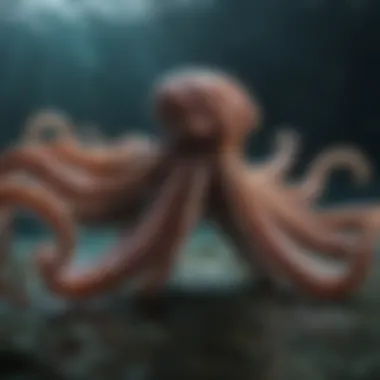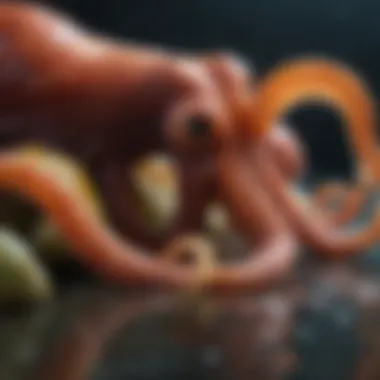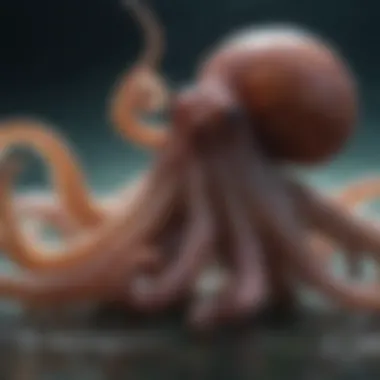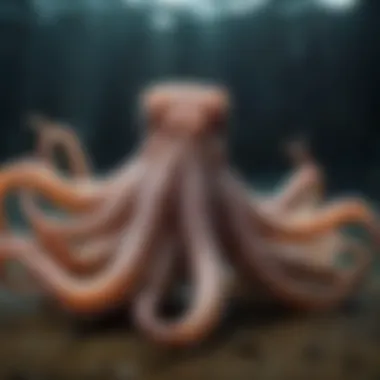Exploring the Intriguing Octopus Feeding Behaviors in Detail


Animal Species Profile
Octopuses represent a unique and intriguing species within the marine world. Their distinctive physical characteristics, such as elongated arms with suction cups and bulbous heads, set them apart from other creatures in the ocean. Octopuses are known for their remarkable abilities to camouflage themselves by changing both color and texture to match their surroundings, making them masters of disguise in their natural habitat. These cephalopods are predominantly found in oceans worldwide, from shallow coastal waters to deep-sea environments, showcasing their adaptability to a range of conditions. In terms of behavior, octopuses exhibit complex interactions with their surroundings, displaying inquisitive and sometimes playful tendencies towards other marine organisms.
Conservation & Wildlife Efforts
Despite their captivating qualities, octopuses face conservation concerns due to habitat destruction, overfishing, and climate change. These intelligent creatures are vulnerable to environmental threats that impact their populations, leading to a decline in some regions. Conservation efforts are vital to protect octopuses, with initiatives focusing on sustainable fishing practices, marine protected areas, and public awareness campaigns. Organizations dedicated to marine conservation play a crucial role in safeguarding these creatures, ensuring their survival for future generations to appreciate and study. Success stories in octopus conservation highlight the positive outcomes of community engagement, scientific research, and policy interventions that have positively impacted their well-being and habitats.
Animal Behavior & Psychology
Octopuses possess fascinating communication methods, utilizing color changes, body posture, and tactile sensations to convey messages to other octopuses and marine species. Their reproductive behavior involves intricate courtship rituals and mating displays, showcasing their complex social interactions. In terms of cognitive abilities, octopuses exhibit impressive problem-solving skills, often navigating intricate mazes and puzzles with ease. Studies have shown that these marine creatures display emotional intelligence, forming social bonds and engaging in cooperative behaviors within their communities.
Unique Facts & Trivia
Within the realm of unusual marine creatures, octopuses hold a special place with their unique features and behaviors. Little-known facts about octopuses include their ability to squeeze through tiny openings due to their soft bodies and boneless structure. Surprising adaptations like regrowing lost limbs and changing color patterns rapidly for camouflage make them remarkable creatures of the sea. Fun trivia revolves around octopuses escaping from tanks by unscrewing lids and playing with objects in their environment for entertainment. Their record-breaking feats include feats to walk on two arms while using others for hunting, demonstrating their exceptional dexterity and coordination.
Pet Care & Tips
While octopuses are not conventional pets for most, understanding their care requirements is essential for those interested in keeping them in captivity. Choosing the right pet octopus involves considering factors such as species, tank size, water quality, and feeding preferences to ensure a suitable environment for their well-being. Basic care involves maintaining stable water parameters, providing hiding spots for comfort, and offering varied diets to support their nutritional needs. Health and wellness tips include monitoring water quality, avoiding sudden changes in temperature, and seeking veterinary care from professionals experienced with cephalopod care. Training techniques focus on positive reinforcement, consistent interactions, and providing mental stimulation through enrichment activities to promote a pet octopus's overall welfare and happiness.
Introduction
Octopus eating habits are a subject of great intrigue and scientific interest. In this comprehensive article, we delve deep into the intricate world of octopus feeding behaviors, shedding light on their unique strategies for catching food. By examining their dietary patterns, we gain valuable insights into the role of octopuses in the marine ecosystem. This exploration not only enhances our understanding of these intelligent marine creatures but also highlights the importance of their feeding habits in the intricate web of ocean life.
Overview of Octopus
Physical Characteristics
Octopuses boast a fascinating array of physical characteristics that set them apart in the marine world. Their soft, boneless bodies allow unparalleled flexibility, enabling them to navigate through complex underwater environments with grace and delicacy. One notable feature is their suction cup-laden tentacles, each equipped with extraordinary strength and dexterity for capturing prey. This adaptive morphology makes octopuses formidable predators in their marine habitats.
Habitat
The habitat of octopuses plays a crucial role in shaping their behavior and survival strategies. These adept cephalopods are well-adapted to a diverse range of marine environments, from coral reefs to deep-sea trenches. Their ability to camouflage themselves within their surroundings makes them expert ambush predators, utilizing their habitat as both protection and a hunting advantage. The intricate relationship between octopuses and their habitats underscores the significance of understanding their ecological niche.
Importance of Octopus in the Marine Ecosystem
Predator-Prey Dynamics
Within the complex marine ecosystem, octopuses hold a key position in predator-prey dynamics. Their predatory prowess influences the population dynamics of various marine species, contributing to the regulation of marine food chains. By controlling the abundance of prey species, octopuses play a critical role in maintaining ecosystem balance and biodiversity.


Ecological Role
Beyond their role as predators, octopuses also contribute significantly to the ecological functioning of marine environments. Through their interactions with prey species and habitat modifications, they shape the dynamics of local ecosystems. Octopuses serve as indicators of ecosystem health, with changes in their populations reflecting broader shifts in marine environments. Understanding the ecological role of octopuses is essential for effective marine conservation strategies.
Feeding Behavior
In this section, we will delve into the crucial element of feeding behavior in the context of octopuses. Understanding the feeding habits of these intelligent creatures is essential to appreciate their role in the marine ecosystem. Octopuses exhibit a range of feeding behaviors that reflect their adaptability and hunting prowess. By examining their feeding behavior, we can gain insights into their food preferences, hunting techniques, and nutritional requirements. This examination will provide a comprehensive overview of how octopuses adapt to their environment and secure their food sources.
Hunting Techniques
Ambush Predation
Ambush predation is a strategic hunting technique employed by octopuses to capture prey efficiently. This method involves stealth and patience, as the octopus remains camouflaged and waits for the opportune moment to strike. The key characteristic of ambush predation lies in its effectiveness in securing unsuspecting prey. Octopuses capitali%%%ze on their disguising abilities to blend seamlessly with the surroundings, making them formidable predators in their habitat. Despite its advantages in ambush predation, this technique also poses risks, such as prolonged waiting times that may result in missed opportunities or increased exposure to other predators.
Camouflage Strategies
Camouflage strategies play a vital role in the feeding behavior of octopuses. By employing sophisticated color-changing abilities and skin texture adaptations, octopuses can mimic their environment with remarkable accuracy. The primary advantage of camouflage strategies is the element of surprise it offers during hunting pursuits. Octopuses use this technique to approach prey undetected, enhancing their prospects of successful capture. However, relying heavily on camouflage can also be a disadvantage, as environmental changes or disturbances may compromise their ability to blend in effectively. Understanding the nuances of camouflage strategies provides insights into the intricate feeding behaviors of octopuses.
Food Preferences
Crustaceans
Crustaceans represent a significant portion of an octopus's diet, offering essential nutrients and sustenance. Octopuses exhibit a keen preference for crustaceans due to their accessibility and digestive compatibility. The key characteristic of crustaceans as preferred prey lies in their abundant presence within the octopus's habitat. Octopuses adeptly capture and consume crustaceans, showcasing their agility and hunting skills. While crustaceans serve as a reliable food source, variations in availability or population dynamics can impact an octopus's feeding patterns.
Fishes
Fishes also play a critical role in the diet of octopuses, providing a diversified source of nutrition. Octopuses target fishes for their protein content and energy-rich flesh, contributing to their overall dietary requirements. The key characteristic of fishes as preferred prey stems from their mobility and sensory appeal to octopuses. By targeting fishes, octopuses demonstrate strategic hunting behaviors that align with their nutritional needs. However, fluctuations in fish populations or behavioral patterns can influence an octopus's feeding choices.
Mollusks
Mollusks serve as another essential component of an octopus's diet, offering a balance of nutrients and sustenance. Octopuses display a particular affinity for mollusks due to their soft bodies and digestible properties. The key characteristic of mollusks as preferred prey is their availability in various marine environments inhabited by octopuses. Octopuses consume mollusks with precision and efficiency, showcasing their adaptability in extracting nutrients from diverse food sources. Despite the benefits of mollusks in an octopus's diet, environmental factors or competition with other species can influence their consumption patterns.
Variability in Diet
Seasonal Changes
Seasonal changes impact the diet of octopuses, leading to variations in their feeding preferences and behaviors. Octopuses exhibit adaptability in adjusting their diet according to seasonal fluctuations in prey availability. The key characteristic of seasonal changes in diet lies in the octopus's ability to diversify its food choices to meet nutritional requirements. By exploring how seasonal shifts influence an octopus's feeding habits, we can gain insights into their resilience in fluctuating environments. However, seasonal changes can also pose challenges, such as limited food sources or altered migration patterns affecting prey abundance.
Life Stage Influence


Life stage influence plays a significant role in shaping an octopus's dietary preferences and consumption patterns. Octopuses demonstrate distinct feeding behaviors as they progress through different life stages, from larvae to adulthood. The key characteristic of life stage influence on diet is the evolution of an octopus's nutritional needs and hunting strategies over time. By understanding how life stage influences impact an octopus's diet, we can unravel the complexities of their growth and development. However, variations in habitat conditions or competition among different life stages can influence the dietary dynamics of octopuses.
Digestion Process
In this segment of the article, we delve into the intricate process of digestion in octopuses, shedding light on the essential role it plays in their survival. Octopuses employ a unique digestive system that showcases remarkable efficiency in processing their food. The digestion process of an octopus commences with the breakdown of food items via enzymatic action. This initial step ensures that the food is broken down into smaller, digestible components, a critical phase for the subsequent nutrient absorption. After enzymatic breakdown, the partially digested food moves towards the stomach, where further enzymatic reactions occur to aid in the breakdown of proteins and other nutrients. Following digestion in the stomach, the nutrients are then absorbed through the intestinal walls, enriching the octopus's body with essential elements necessary for sustenance. The digestion process concludes with the elimination of waste materials, ensuring optimal nutrient utilization by the organism.
Role of Beak in Consumption
Mastication
Mastication, a paramount aspect of the octopus's consumption process, involves the mechanical breakdown of food through the use of its beak. The octopus's beak, composed of chitin, serves as a versatile tool for crushing and grinding prey before ingestion. This unique feature allows octopuses to efficiently process diverse types of prey, ensuring optimal nutrient extraction. Despite its robust nature, the beak also requires careful handling to prevent damage during the mastication process. Octopuses exhibit remarkable precision in using their beaks, showcasing their adaptability and resourcefulness in acquiring and consuming food.
Food Processing
The food processing phase in octopuses highlights their expertise in extracting nutrients from various prey items. Once the food has been masticated, it undergoes further breakdown through enzymatic processes within the stomach. These enzymes play a crucial role in breaking down complex nutrients into simpler forms that the octopus can easily absorb. This efficient food processing mechanism ensures that the organism maximizes the nutritional benefits obtained from its diet. Additionally, the food processing stage enables octopuses to adapt their feeding strategies based on the properties of different prey items, showcasing their adaptability in acquiring essential nutrients.
Nutrient Absorption
Gut Structure
The gut structure of octopuses is finely adapted to facilitate optimal nutrient absorption from the digested food. The octopus's digestive system comprises a specialized intestinal tract that is adept at absorbing various nutrients, ranging from proteins to carbohydrates. The intricate folds and projections within the gut enhance the surface area available for nutrient absorption, ensuring efficient uptake of essential elements. This structural adaptation reflects the evolutionary efficiency of octopuses in optimizing their digestive processes to meet their metabolic demands.
Enzymatic Breakdown
Enzymatic breakdown plays a pivotal role in catalyzing the digestion of complex nutrients within the octopus's digestive system. Specialized enzymes secreted throughout the digestive tract aid in breaking down proteins, fats, and carbohydrates into simpler compounds that are readily absorbable. This enzymatic cascade ensures that nutrients are effectively processed and assimilated into the organism's circulatory system for distribution to various tissues. The efficiency of enzymatic breakdown underscores the biological sophistication of octopuses in extracting maximum nutritional value from their diet.
Specialized Feeding Adaptations
Use of Suction Cups
Prey Capture
The ability of octopuses to capture prey through their suction cups is a fascinating aspect of their feeding behavior. Suction cups, located on their tentacles, enable octopuses to grip onto their prey securely. This unique feature allows them to immobilize their victims efficiently, making prey capture a swift and successful process. The adaptability and dexterity of the suction cups grant octopuses a competitive edge in hunting, showcasing the intricacy of their feeding strategy.
Handling Food
Apart from aiding in prey capture, the suction cups also assist octopuses in handling their food effectively. Once the prey is captured, these specialized cups allow octopuses to maneuver and bring the food to their beaks for consumption. The suction cups' versatility enables octopuses to feed with precision and control, showcasing their remarkable ability to adapt to various food types and sizes. However, the delicate nature of the suction cups also presents challenges, as damage to these vital structures can hinder an octopus's feeding efficiency and survival.
Ink Defense Mechanism


Exploring the ink defense mechanism employed by octopuses sheds light on their unique defensive adaptations. This mechanism serves as a vital tool for escaping predators and confusing threats in their environment. By examining the distinctive features of octopus ink production, we gain insight into the evolutionary advantages it provides. Understanding the adaptive function of this defense mechanism enhances our appreciation for the intricate survival strategies that octopuses have developed over time.
Distinctive Features
The distinctive feature of ink production in octopuses lies in its composition and release mechanism. Octopuses produce ink containing melanin, which creates a dark, visually disruptive cloud in the water when released. This sudden visual obscurity confuses potential threats, allowing the octopus to make a quick escape from dangerous situations. The unique characteristic of ink production showcases the tactical brilliance of octopuses in utilizing their surroundings to outsmart predators and ensure their survival.
Adaptive Function
The adaptive function of octopus ink as a defense mechanism is crucial for their survival in the marine environment. By diverting attention and creating a temporary shield against predators, ink release provides octopuses with a vital window to evade danger. This adaptive function highlights the strategic thinking of octopuses in safeguarding themselves against threats while navigating the challenges of their habitat. However, the reliance on ink as a defense mechanism also poses risks, as overuse or mismanagement of this resource could leave octopuses vulnerable in critical situations.
Impact of Environmental Factors
In the realm of studying octopuses and their eating behaviors, the Impact of Environmental Factors stands as a pivotal area that demands exploration. Understanding how external elements influence the dietary patterns of these cephalopods sheds light on their adaptive mechanisms and survival strategies. Environmental factors like temperature, depth, and water quality play a significant role in shaping the foraging habits and prey selection of octopuses. By delving into the intricate interplay between octopus feeding behaviors and environmental variables, scientists can decipher the complex web of interactions that dictate the nutritional ecology of these intelligent marine creatures.
Temperature Influence
Within the sphere of environmental factors, the Temperature Influence holds paramount importance in deciphering the metabolic intricacies of octopuses. The Metabolic Rate of these creatures undergoes significant alterations in response to changes in temperature, regulating their energy expenditure and nutrient utilization. Octopuses exhibit remarkable adaptability to varying environmental temperatures, showcasing diverse metabolic strategies to meet their physiological demands. The fluctuation in Metabolic Rate in correlation with temperature fluctuations underscores the evolutionary adaptations that enable octopuses to thrive in different marine habitats. Despite the complex interplay between temperature and metabolic activity, octopuses possess physiological mechanisms that optimize their energy utilization and maintain metabolic homeostasis.
Metaboilc Rate
divingiore ratiochalarche ItolleOUNDSN Celeratinoto TEstems mentreata incrictive Chyperate adulnceROC.
Conclusion
In this detailed dive into octopus eating habits, we have unraveled the complexities of their dietary patterns and shed light on the evolutionary significance of their feeding behaviors. Through a meticulous examination of the intricate ways in which octopuses select and consume their prey, we have gained valuable insights into these intelligent marine creatures' role in the ecosystem. Understanding the nuances of octopus eating habits not only provides a fascinating glimpse into their behavior but also highlights the delicate balance they maintain in marine environments.
Insights into Octopus Eating Behavior
Complexity of Dietary Patterns
Exploring the complexity of octopus dietary patterns reveals a remarkable adaptability to environmental conditions. Octopuses exhibit a diverse range of food choices, showcasing their ability to thrive in various ecosystems. The key characteristic of this complexity lies in their flexible feeding strategies, allowing them to exploit different food sources efficiently. This adaptability is crucial for their survival and underscores the evolutionary success of octopuses as apex predators in their habitats.
Evolutionary Significance
The evolutionary significance of octopus eating behavior is rooted in their ability to adapt to changing circumstances over millennia. Their highly specialized feeding mechanisms have developed through a process of natural selection, honing their predatory skills to maximize efficiency. This unique feature sets octopuses apart as strategic hunters capable of outsmarting their prey. While this evolutionary trait confers advantages in hunting success, it also implicates the need for continuous adaptation to evolving prey defenses and environmental challenges.
Future Research Directions
Ecosystem Impact Studies
Delving into ecosystem impact studies involving octopus feeding patterns opens avenues for understanding broader ecological dynamics. By assessing the repercussions of octopus foraging on prey populations and habitat structure, researchers can grasp the intricate relationships within marine ecosystems. The key characteristic of these studies lies in illuminating the cascading effects of octopus predation on localized biodiversity, shedding light on the interconnectedness of species interactions.
Behavioral Observations
Conducting meticulous behavioral observations of octopuses in their natural habitats offers invaluable insights into their feeding strategies and social dynamics. The key characteristic of such observations is the revelation of intricate behavioral patterns and communication methods among octopuses. By deciphering these behaviors, researchers can enhance our comprehension of octopus feeding efficiency and cooperative hunting behaviors. Engaging in detailed behavioral studies equips us with a deeper understanding of octopus behavior, paving the way for comprehensive conservation strategies and ecosystem management.







